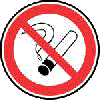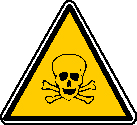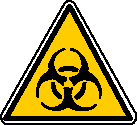 Like
many other we suffer from cigarette secondary smoke. However, we do have one
less mechanism to combat its consequences: tears. Thus,
as many persons suffering from reduced lung capacity, we suffer form the
consequences of tabacco almost immeadiately, unlike most
persons, who will only suffer from long term
consequences. Nonetehless, banning tabacco from public places remains an
essential heatlh issue for everyone. As such, banning tabacco is one of the
prioritary fights to improve easily our quality of life
and reduce the social exclusion to which we are exposed by these
"social"(actually it's all the opposite of being social but still) addictive
behaviours. We are often chassed from public places since the ban is really not
in place or not respected in many countries. The absence of appropriate action
by public authorities and society in general is seen by Keratos as negligence,
whenever public places are concerned (companies, public transportation,
restaurants, etc).
Like
many other we suffer from cigarette secondary smoke. However, we do have one
less mechanism to combat its consequences: tears. Thus,
as many persons suffering from reduced lung capacity, we suffer form the
consequences of tabacco almost immeadiately, unlike most
persons, who will only suffer from long term
consequences. Nonetehless, banning tabacco from public places remains an
essential heatlh issue for everyone. As such, banning tabacco is one of the
prioritary fights to improve easily our quality of life
and reduce the social exclusion to which we are exposed by these
"social"(actually it's all the opposite of being social but still) addictive
behaviours. We are often chassed from public places since the ban is really not
in place or not respected in many countries. The absence of appropriate action
by public authorities and society in general is seen by Keratos as negligence,
whenever public places are concerned (companies, public transportation,
restaurants, etc).
There is no need to carry out more scientific
studies on the ocular consequences of tabacco. These already exist for most
components of cigarette smoke taken individually. The regular cigarette contains
approximately 4 000 chemical components and some of
them, are much more present in the air than in the smoke swalloled by the
smoker.



Considering its components,
cigarette packs should have the following signs marked upon the
packs.
Secondary smoke
contains among other things:
-
carbon monoxyde - asphyxiant gaz reducent the
oxigenation of tissues,
-
formaldehyde
- irritant gas used as disinfectant
and well known cancerigenous,
-
benzene
- inflammable liquid,
highly toxic and irritant,
-
nicotine -
addictive substance. Also
used as an insecticide.
-
ammoniac
- used to make explosives, fertilisers and solvants
for paint,
-
arsenic -
known as highly cancerigenous for the skin and
lungs,
-
cyanhydric
acid - violent poison, extremely
nocive for the lungs,
-
acetaldehyde
- inflammable liquid,
toxic and irritant,
-
acetonitrile
- toxic and used to make plastic substances,
-
formic
acid - strong irritant,
-
acroleine
- irritant, toxic and cancerigenous
liquide,
-
methyl
chloride - toxic gas,
-
hydrogene cyanure - a deadly poison !
-
methanol
- toxic alcohol,
-
nitrate
oxide - combined with hydrocarburates
(and therefore street pollution) contributes to the
creation of smog,
-
proprionaldehyde
- disinfectant liquid,
-
pyridine -
inflammable liquid used as an
insecticide and bactericide,
-
hydrogene
sulfite - toxic gas produced by decomposing
chair.
Second-hand smoke
contains twice as much nicotine and tars than the one inhaled by the
smoker.
The first visible signs
are inflammation,
vasodilatation and
conjunctival
rendness.
Bellow a study, carried out in Germany, on the
effect of tabacco on healthy eyes, demonstrating that tabacco
affects tear proteines, and increases the incidence of dry eye
symptomes:
|
Effect of smoking on tear proteins
Franz H. Grus, Perikan Sabuncuo, Albert Augustin, Norbert Pfeiffer A1 Department
of Ophthalmology, University of Mainz, Langenbeckstr. 1 55101 Mainz, Germany
Purpose. Cigarette smoking is a
serious risk factor for many diseases, e.g., cardiovascular and pulmonary
diseases. It is also a risk factor in several eye diseases, including macula
degeneration, glaucoma, and cataract. Ischemic, toxic, and oxidative effects
of cigarettes are thought to play an important role in damaging ocular
tissue. Furthermore, smoking can cause symptoms of dry-eye disease. The aim
of this study was to analyze and compare electrophoretic patterns in tears
of smokers (SP), severs smokers (SSP), and nonsmokers (CTRL).
Conclusion. Electrophoretic analysis
of tear protein patterns could detect changes in tear proteins of smokers in
comparison to nonsmokers. These changes were correlated with an increase of
dry-eye-related subjective symptoms in smokers. Thus, electrophoretic
analysis of tear proteins provided greater insight into the pathogenesis of
smoking-induced ocular surface diseases. |
Bellow two studies carried out in Turkey
(one of them also involved japanese researchers) on the effect
of tabac on the ocular surface on healthy eyes, demonstrating that tabacco
affected the ocular surface and the normal characteristics of tears:
|
The effects of chronic
smoking on the ocular surface and tear characteristics: a clinical, histological
and biochemical study
Satici A.[1]; Bitiren M.[2]; Ozardali I.[2]; Vural H.[3]; Kilic A.[1];
Guzey M.[1] [1] Department of Ophthalmology, Harran University Medical School,
Sanliurfa, Turkey [2] Department of Pathology, Harran University Medical School,
Sanliurfa, Turkey [3] Department of Clinical Biochemistry, Harran University
Medical School, Sanliurfa, Turkey
Conclusions: In chronic smokers, we found
decreased tear film break-up time (p = 0.022) and tear lysozyme concentration (p
= 0.013), and increased Schirmer I-test values (p = 0.047), squamous
metaplasia scores (p = 0.016), eye irritation scores (p < 0.001) and eye
irritation indices (p = 0.013), as compared with the control group. There were
no statistically significant differences in goblet cell counts (p = 0.710) or
rose Bengal staining scores (p = 0.827). These findings suggest that chronic
smoking has a negative effect on the ocular surface and affects some tear
characteristics. The chronic ocular irritative effects of cigarette smoking may
lead to defects in ocular surface defence.
Smoking Associated With Damage to the Lipid Layer of the Ocular Surface,
Dilek Dursun Altinors, Sezin Akça, Yonca A. Akova , Banu Bilezikçi, Eiki Goto, Murat Dogru and Kazuo Tsubota.
Department of Ophthalmology, School of Medicine, Baskent University, Ankara, Turkey, Keio University School of Medicine, Department of Ophthalmology, Tokyo, Japan.
American Journal of Ophthalmology, Volume 141, Issue 6,
June 2006,
Page 1016.
Conclusion: Smoking has deteriorating effects on the lipid layer of precorneal
tear film,
|
Bellow additional links on the ocular
consequences of tabacco smoke:
It's easy to image the consequences on fragile and
diseased eyes!
Some claim a so-called smoking liberty to
impose it on everyone else. It is neither a right (considering it carry
consequences for others) nor a liberty (it's precisely the opposite, since it's
an addiction). Smoking is nothing but the expression of freedom, it's just an
unfortunate dependance to nicotine and other substances that some are willingly
imposing to others. Everyone is free to ruin one health as ong as one does so
alone. Smoking should remain a private and individual choice for all consenting
adults (therefore we believe kids should be excluded from this expression
"liberty".

Keratos is involved in banning tabacco from
public places in France. For the time being is still not safe for a dry eye
sufferer to go to a French restaurant, bar or disco. This situations will change
in January 2008 when tabacco will be banned from all public places. Until then,
buy a gas mask! To learn more about this subject please read the French section
of this website.
▲

copyright ©
Keratos 2005-2007